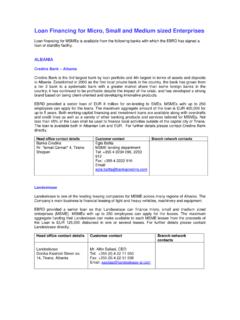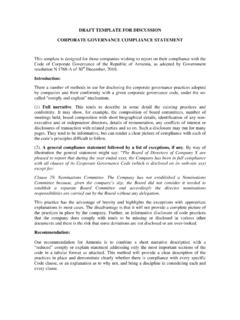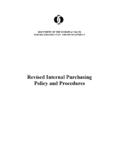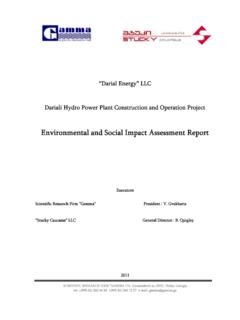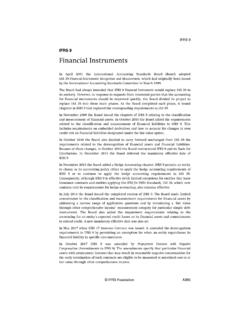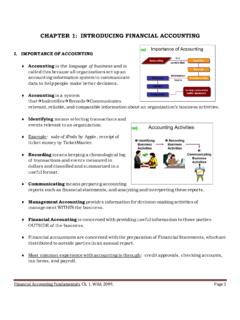Transcription of Chapter 3 DRIVERS Of INNOVATION - European Bank for ...
1 44 Chapter 3 EBRD | TRANSITION REPORT 2014 DRIVERS Of INNOVATION R&D incReases the likelihooD of intRoDucing new pRoDucts oR pRocesses by26%foR high-tech manufactuRing fiRmsfiRms that use ict aRe9%moRe likely to intRoDuce new pRoDucts oR pRocesses29%of expoRteRs have intRoDuceD a new pRoDuct oR pRocess, compaReD with 15% of non-expoRteRsAt A glAnceChapter 3 DRIVERS Of INNOVATION45 Firms that innovate are more sensitive to the quality of their business environment. they tend, in particular, to complain about corruption, the limited skills of the workforce and burdensome customs and trade regulations. Reducing such business constraints can have a significant positive impact on firms ability and willingness to innovate.
2 In countries where constraints are less binding, firms tend to innovate more as a result. However, not all firms in such countries are innovative: the age, size, ownership structure and export status of companies also have an is an important driver of improvements in productivity. But what drives INNOVATION itself? This Chapter looks at the reasons for the significant variation seen in the rates of INNOVATION of individual countries and sectors, as documented in Chapter factors influence firms incentives and ability to innovate, ranging from the prevalence of corruption to the availability of an adequately skilled workforce and access to finance.
3 Some of these factors are internal, reflecting either characteristics of the firm (its size or age, for instance) or decisions made by the firm (such as the decision to compete in international markets or the decision to hire highly skilled personnel). Other factors are external and shape the general business environment in which firms operate (such as customs and trade regulations). In some cases, the two are closely related: each firm makes personnel decisions that determine its ability to innovate, but these decisions are, in turn, strongly influenced by the prevailing skills mix and the availability of a sufficiently educated workforce in the region where the firm operates.
4 Similarly, Chapter 4 shows that the local banking structure (an element of the external environment) has an impact on firms funding structures (an internal aspect), which then affects INNOVATION . Even if firms share the same business environment, they will not necessarily make the same business decisions, and these decisions will influence their INNOVATION activity. This Chapter examines internal and external DRIVERS of INNOVATION , looking at both firm-level and country-level evidence. The firm-level analysis builds on the first two stages of the model discussed in the previous Chapter , which explained firms decisions to engage in research and development (R&D) and introduce new products or processes.
5 This analysis uses a rich set of data looking at firms perceptions of the business environment. The data were collected as part of the EBRD and World Bank s fifth Business Environment and Enterprise Performance Survey (BEEPS V) and the Middle East and North Africa Enterprise Surveys (MENA ES) conducted by the EBRD, the World Bank and the European Investment Bank. The country-level analysis uses a large sample of countries, including those from the transition region, to explain both INNOVATION at the technological frontier (measured as the number of patents per employee) and the INNOVATION intensity of exports (a broad measure of INNOVATION and the adoption of technology that was introduced in Chapter 1).
6 The Chapter starts by considering DRIVERS of INNOVATION within an individual firm, looking first at firm-level characteristics (such as a firm s size and ownership structure), before turning to decisions made by firms (such as the decision to export or the decision to conduct R&D). The analysis then moves on to external factors, first comparing innovative firms perception of the business environment with the views of non-innovative firms. These views guide the discussion of the key external factors that affect INNOVATION outcomes at country level. 100%oF young FIRms In IsRAel IntRoduce At leAst one pRoduct wHIcH Is new to tHe InteRnAtIonAl mARket, compARed wItH In tHe tRAnsItIon RegIon46 Chapter 3 EBRD | TRANSITION REPORT 20141 See Nightingale and Coad (2013) for a discussion of fast-growing gazelle firms.
7 2 See OECD (2009).3 See, for example, Cohen and Levinthal (1989).firm-level DRIVERS of innovationsize and age of firmsA firm s willingness and ability to innovate will depend on various characteristics. In particular, young, small firms are often perceived to be the main DRIVERS of INNOVATION . While such firms do make an important contribution to the development of new products, they are not necessarily more innovative than other firms when viewed as a whole. This is partly because when young, innovative firms are successful, they often grow fast, thereby becoming larger firms. Google and Amazon were once start-ups with just a handful of employees, but they have quickly grown and now employ thousands of people.
8 Innovative start-ups that are not successful, on the other hand, typically run out of funding and exit the Neither of these types of firm will be categorised as young, small firms in an enterprise survey such as BEEPS V or MENA ES. In addition, not all young, small firms are innovative start-ups. Many will be in conventional service sectors (takeaway restaurants or small convenience stores, for instance). For these reasons, INNOVATION may be more common among larger firms that have been operating for a longer period of time. Chart , which uses BEEPS V and MENA ES data, shows that larger and older firms are indeed more likely to introduce new products.
9 The same is true of new processes and marketing and organisational innovations. A similarly positive correlation between the size/age of a firm and its propensity to introduce new products or processes can also be observed in Israel and advanced economies more The positive correlation between firm size/age and INNOVATION also holds in firm-level regressions. Table presents estimates showing the impact of various firm-level characteristics that influence firms decisions to engage in R&D and introduce new products and processes. These results are based on the model discussed in Chapter 2 (see Box ). Unlike the simple averages presented above, this model takes into account the industries and countries where firms operate, as well as various other firm-level characteristics (such as the type of firm ownership).
10 BEEPS V and MENA ES data suggest that economies of scale may also partly explain the positive correlation between firm age/size and INNOVATION . The development of new products often involves high fixed costs and investment spikes. This may simply be easier for larger firms to bear particularly if large firms enjoy better access to external finance, as discussed in Chapter 4. These large firms may also be more able to absorb new This may be one reason why small firms (defined as companies with fewer than 20 employees) are less likely to engage in R&D than larger firms (albeit they tend to spend a higher percentage of their annual turnover on in-house R&D; see Chart ).



